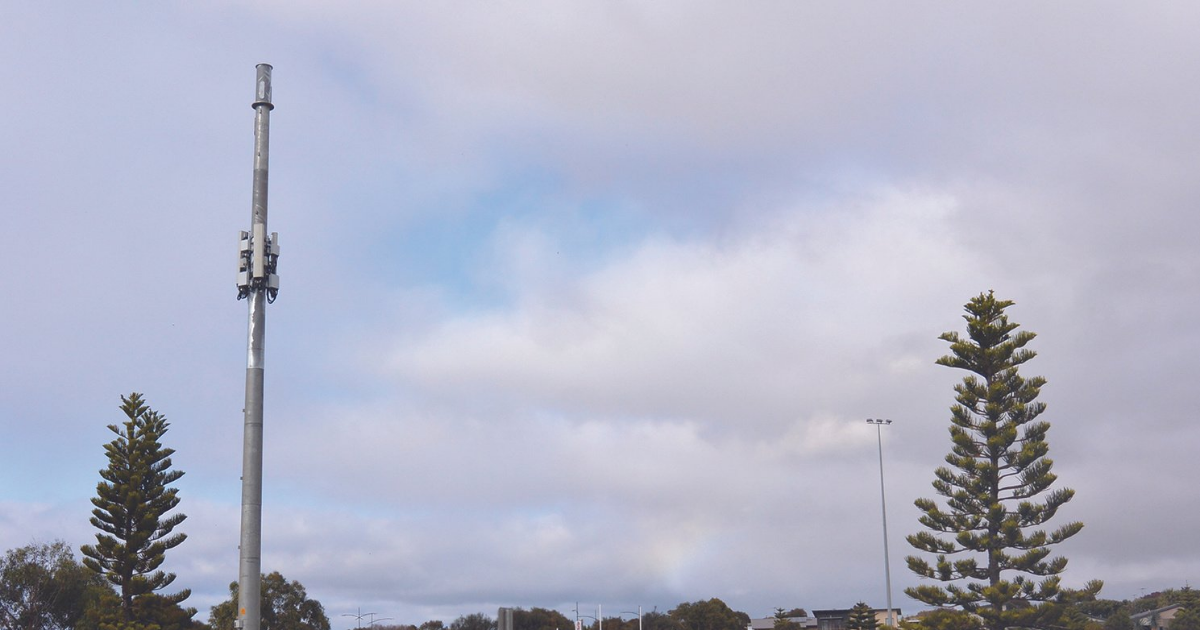Committee for Lorne: Is this our “Barron Moment”? … the coming of giants!
Should building regulators review the height of door frames, mattress makers recalibrate their bed lengths, and architects — by default — increase the dimensions of the adolescent bedroom?
In the last few weeks, three unconnected moments have brought this issue to the fore.
First … a wonderful photo of Rhyll and her grandson Ned Moyle, a ruckman for the Gold Coast Suns [NB: Rhyll is the smaller one] taken at the Lorne Aquatic.
Second … a never-to-be-published shot of my reach-for-the-stars grandson, James, standing alongside this author [NB: the author has unfeelingly been compared to a field mushroom].
Third … and I shrink from saying the one that ‘tops’ them all … is a soon-to-be-iconic photograph taken of ‘The Donald’ as he declared his win on election night USA. Looming up from behind like an adolescent Burj Khalifa is the towering figure of his son Barron, whose reported height is 2.05-2.07m [6’7′ or 6’9″], depending on the Internet source consulted [or perhaps a shoes/no shoes measurement]. Heads up, Andrew Mackie … is there any chance of recruiting Barron for the Cats ruck?
And, speaking of football, Donald [1.9m] is no slouch in the height department and might even have been considered a 1960s ruckman draftee option—if there had been a draft back then! His height would have placed him precisely between two of the greatest ruckmen ever to play footy—Geelong’s Polly Farmer [1.91m], who changed football forever when he introduced the creative hand pass, and Carlton’s captain courageous, ‘Big Nick’ John Nicholls [1.89m]. While in those days, these two legendary leaders and giants of the field towered over their team-mates, it is sobering to think that in a team of today, Polly and Big Nick might just get a game as a ‘mid’, a flanker, or a winger but would certainly be deemed ‘too small’ for a key forward or back role and would never be considered for the ruck.
One thing can be said with certainty … Homo sapiens are getting taller and taller with each generation. Most sons now exceed their father’s height [though I was a sad exception], and this seems to be an ongoing trend. But this apparent human trend bucks most of the size data in the animal kingdom.
Once upon a time, before our species trod this earth, our planet was dominated by megafauna. The dinosaur age is known to all—as is the massive size of some of these extraordinary creatures—but perhaps lesser-known are some of the outsized creatures that roamed our own continent.
Australia is known to have had several outsized versions of our current and unique animals—behemoths that roamed the continent during the Pleistocene era from 2.5 million to 11,700 years ago.
One, the giant wombat-like Diprotodon … its fossilised bones suggest it stood 2m at the shoulder, was 4m in length, and weighed nearly 3 tonnes … appears to have survived until ~7,000 years ago. Thus, it would have shared the continent with our early Aboriginals for thousands of years.
Diprotodon
The following edited extract on megafauna comes from the website of The Australian Museum … https://tinyurl.com/yptkkuup … and helps us to understand what happened to these mega-animals.
“… at the end of the last ice age, as Australia’s climate changed from cold and dry to warm and dry, surface water became scarce, and most of the large, predominantly browsing animals lost their habitat. They progressively retreated to a narrow eastern coastal band with permanent water and better vegetation.”
The Diprotodon was one of these. So, too, was Megalania, a giant goanna that grew to 5m in length and weighed 1.9 tonnes, and Procoptodon, a giant kangaroo that stood 2.7m and weighed up to 250kg—nearly three times the size of the biggest roos today. As the ice melted and the earth warmed, the competition for scarce food saw our continent’s megafauna numbers dwindle till, eventually, all suffered a similar fate of extinction [ref. Wikipedia].
Earth’s temperature has repetitively risen and fallen over the eons—indeed, human existence is enjoying a sweet spot … a ‘Goldilocks moment’… not too hot, not too cold, but just right. In truth, we cannot [1] expect this to last, and [2] there is nothing we can do to stave off the eventual demise of our species. It is naïve to think that any human effort can materially alter these long-term cyclical oscillations in global temperature—mitigation of fossil fuel use and greenhouse gas production amount to tiny threads in nature’s fabric.
An interesting example of the effects of temperature on species survival is currently playing out on the Great Barrier Reef, where the sea turtle population is in trouble from a rising ambient temperature. When the sand is warmer, more female turtle eggs successfully hatch, while male turtle eggs need cooler sand to survive. Warmer temperatures—and hotter sand—is hatching a disproportionate number of female turtles, which, when they reach maturity, find fewer males to fertilise them. In turn, fewer eggs are being laid and fewer hatchlings result … again with a preponderance of females. It is a path to extinction.
But I digress! … back to our ‘Barron moment’. As, in general, most of the maxi-variants of animal species have now disappeared [elephants, hippos, and giraffes remain but are much smaller than they once were], humans appear to be one of the few species that are growing bigger, generation on generation. It’s like witnessing Darwinism at work, and in real-time. An ageing article in Scientific American … https://tinyurl.com/msddxxmc … suggests [1] that the trend is real and [2] it is primarily the result of improved nutrition.
This will soon impact some of the measures we take for granted—like doorway heights. The most common internal door height in an Australian home is 204 cm … https://tinyurl.com/ysad897n … and our young may soon be cracking skulls at an alarming rate. There is a persuasive argument for reviewing this regulation. You may have some fun thinking of other examples!
Certainly, were a young Barron Trump ever to visit me ‘at mine’—may your god forbid it—he would soon bash his brains out on my doorways!
John Agar
Feature Writer
A word from the chairman
Hello
As the dust settles after the US elections, the world waits to see whether rhetoric turns into action and what this might mean for world stability and the Australian economy. We as a country will need to be adaptable and resilient and to be grateful that, despite the chest-pumping of our leaders, we are a small player on the world stage, and for that we should be grateful.
Closer to home, the Surf Coast Shire election results have been declared and we are delighted that Lorne’s Leon Walker has been elected to council along with returning councillors, Libby Stapleton and Mike Bodsworth. With three independent councillors in the Otway Range ward, we are confident that they will push for a focus on local issues, and that Lorne will have a strong voice at the council table. Congratulation to Libby, Leon and Mike and thanks to Kate Gazzard for standing for election and for her past service our community.
Special thanks also to our retired councillor, Gary Allen, who is back in town after a well-earned break. Gary embraced the role of councillor, and devoted a huge amount of time, energy and emotion to his 4-year term. I am sure Gary will be thanked and his service recognised by the Lorne community in an appropriate way.
*****
Lorne Cricket Club continue on their winning way with a comprehensive win (3/240 v 2/164) against West Warrion. I was delighted to read that our 12-year-old debutant took a wicket. It proves that age is no barrier at either end of the spectrum. The club is always looking for more players, so get on board with a winning team.
*****
I was intrigued recently to read (in the New York Times) about the concept of “blue zones” where people regularly remain vibrant and active into their 90s and 100s. While the existence of such zones has not been scientifically verified, it was found that the residents were “more likely to eat a nutritious diet with lots of fruit and vegetables, get plenty of physical exercise, prioritize family and community and not smoke cigarettes.” Drinking in moderation, not eating too much, managing stress, having a purpose in life, dedication to religion and good genes were other factors mentioned.
Reading the article made me think about Lorne, as many of the attributes referred to therein are evident in Lorne, the septuagenarian 7.30am bike-riders, the veteran 8am pier swimmers, the ageless 7.30am mermaids and the many walkers, many with dogs, who seize the day as the sun comes up. Smoking is a rarity, drinking is always done in moderation, many have found a purpose in life here through one or more of the community organisations, and how could you be stressed living in Lorne! To sum up, the author said “good health comes from being in the right environment.” Sounds like Lorne to me.
The Aquatic Club is holding its AGM on Saturday November 23 at 5pm, all are welcome.
Cheers
Lorne Ward Events Calendar
November
16 – Affinity Quartet at Qdos Fine Arts, 4-6pm. Doors and Gallery Bar open 30 minutes prior to performance. Tickets $50, reservations recommended
29 – Lorne FNC AGM, Stribling Reserve at 5pm. Committee nomination forms can be on the website to be lodged at [email protected]

















